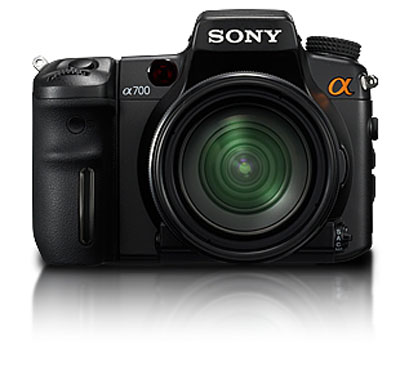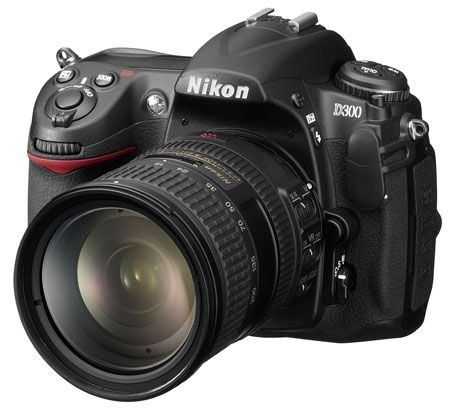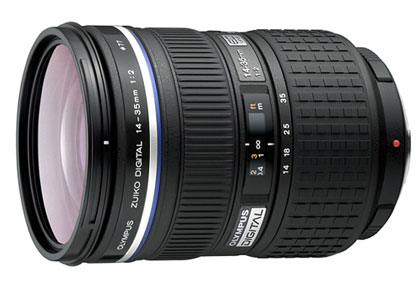Digital Camera Buyers' Guide - Year of the SLR
by Wesley Fink on November 23, 2007 6:00 AM EST- Posted in
- Digital Camera
Prosumer SLRs
It seems everyone is introducing new prosumer models. Understanding what's hot in this market of hard-to-please photography buffs will help you know what to look for in an entry-level camera. If you're in the market for one of these advanced amateur DSLRs, you may want to pay closer attention.

Sony started this prosumer round, just as they started the 10 megapixel (MP) round last year. The new top-of-the-line Sony is now their $1400 A700. Those who doubted that Sony was in the digital SLR market to win were greeted with a slick, stylish, and very fast 12.2MP DSLR with image stabilization, auto dust cleaning, a 3" hi-res LCD, 5.0FPS shooting, and new Sony brand lenses. Conspicuously absent is Live View, a feature pioneered by Olympus on DSLR cameras that allows the user to see through the lens on the LCD. This is standard fare on a point-and-shoot, but difficult to do with the "through-the-lens" optical viewing that is a feature of SLR technology.

Because they are so huge and influential in the photo market, Canon prosumer models receive lots of scrutiny. The new Canon model is the 40D, which continues the 20D/30D models that have defined the Canon prosumer DSLR. The 30D is 8MP and the 40D raises that to 10MP. Many expected an even higher-resolution 40D, but instead the 40D features the same 10MP resolution seen in the entry-level Canon XTi for the past year. New for the $1300 40D is much faster auto-focus, a 3" LCD replacing the 2.5", dust cleaning on startup, dust sealing, and Live View - a first for Canon. There are many other improvements, but they refine existing features of the Canon line.

Nikon announced - but has not shipped - the new D300, which is an update to the D200. The D200 got lost in the wake of the entry-level D80 last year. Nikon uses Sony sensors with their own electronics, and it appears the new D300 uses the same Sony 12.2MP CMOS sensor with on-sensor noise reduction found in the Sony A700. The D300 will launch at a street price of about $1800. The D300 also features a 3" hi-res LCD, very fast autofocus, Nikon's first auto sensor-cleaning system, 6FPS shooting, dust/splash sealing, and Live View.

Olympus has come to life recently, just when many had all but given up on them. Always the innovator, Olympus pioneered auto dust cleaning and Live View on digital SLR cameras based on their "digital-only" 4/3 standard. However, the Olympus 4/3 system was getting very long in the tooth, with a 5.5MP pro model E-1 introduced in 2003. Olympus has just started shipping their new E-3 flagship, which thoroughly updates the Olympus system.
Olympus says the E-3 is their pro model, and it features dust and splash sealing for both the E-3 body and pro lenses. The E-3 also introduces the first new AF module for Olympus in many years. The new AF, which was long overdue, features 11 cross-type sensors, each on two planes, for a total of 44 segments. According to Olympus, the result is the fastest auto focusing SLR you can buy when used with their new SWD (Sonic Wave Drive) lenses, such as their new 12-60mm f2.8-4.0 (24mm-120mm equivalent). The street price of $1699 is much less expensive that the $5000+ entry price for Nikon and Canon pro models. Many, however, feel the real competition for the E-3 is the "prosumer" Nikon D300 and Canon 40D.
The E-3 is also the first Olympus pro model to feature built-in flash, and it's dust and splash sealed. Auto sensor cleaning is a feature, image stabilization is built in and works with all lenses, and the latest incarnation of Live View with a fold out articulating LCD screen is featured. The LCD screen is 2.5", and not the 3" screen of competing models, but competing models don't have a flip-out LCD. Resolution is 10MP, but the E-3 supports ISO-3200 and it is definitely the low-noise camera many didn't think was possible with the smaller 4/3 sensor.
Canon ditched their FD breech mount years ago when they first introduced the EOS autofocus system. That risky move has paid off handsomely for Canon with their current line of all electronic, lens-motor driven lenses. Olympus took a similar tact by ditching their OM mount for an all-electronic mount for digital cameras. However, Olympus didn't have the influence of a Canon when they championed a smaller 4/3 standard sensor and claimed that lenses needed different designs for best digital performance. This was regarded by most of us as marketing-speak, but recent reviews of Olympus glass are showing their 4/3 lens designs - even their cheap kit lenses - do have less light fall-off and are generally sharper in digital photography than competing systems using APS-C or 35mm lenses.

The bottom line is the E-3 and recent Olympus lenses like the pro 14-35 f2.0 zoom (equivalent 28-70mm) and the tiny, cheap, but excellent quality 40-150mm (equivalent 80-300) f4.0-5.6 kit lens may finally gain Olympus the respect in the digital SLR market that has eluded them up to now.










74 Comments
View All Comments
andrew007 - Friday, November 23, 2007 - link
Oh yeah, almost forgot. There is one more complaint - focus hunting. I never had a SLR before so I can't compare but it seemed to me that E410 has trouble focusing in some situations (not just low light) more than an DSLR should. It does have the least focus points of any DSLR if I remember correctly so that may be the reason. In the end I often just use the center sensor and manually lock focus, then do the composition.haplo602 - Friday, November 23, 2007 - link
Hey nice to see the new DSLR buyers guide.I'd comment on the missing Pentax K10D, but who cares ? No Live View, only 10MP, 22bit A/D, dust and weather sealed, image stabilisation. AND a VERY long supply of high quality Pentax lenses... sub 1000$ ... but who cares ? It's last year news (tho you cover olympus 410/510 which are also not new).
I see you adapted the computer world obsession for numbers and new models. Get rid of it. Fast.
If I would buy a new DSLR now it would be either Pentax K10D (and I own a few Nikon lenses) or the Nikon D300 (but this is the more expensive decision).
Frumious1 - Friday, November 23, 2007 - link
Yes, I'd comment on the missing Pentax K10D... except it's already on page 5."Alternative: If low-light performance is a major concern, then you would do well to choose the Sony A100 kit with the 18-70mm kit lens. For a bit more money, the Pentax K10D gives you a great 11-point focus module, all the other features, and pro-type dust and moisture sealing."
haplo602 - Monday, November 26, 2007 - link
Ah ... I knew I missed the Pentax section with nice picture of the K10D and a 1/2 page description like all the others got ... NOT !melgross - Friday, November 23, 2007 - link
I don't understand the statement here that only full frame and 4/3 are standard. This seems to be some prejudice on the part of the writer, who seems to be pushing Olympus very strongly.The APS "C" sensor is more standard than is the 4/3. Just take a look at how many companies are producing "C" sensors, and how many are producing 4/3.
That said, my 5D does produce some of the best pictures around (though I'm looking forward to its expected replacement at the PPA in March.
lumpy327 - Friday, November 23, 2007 - link
Glad to see this column back!! Good article overall, but I wish Pentax had been included too, I miss HyperProgram from my film camera.As a photography student, I'd like to add my two pennies worth to deciding on what camera.
First, if you have good lenses from older cameras, consider sticking w/ that brand. Bodies are cheap compared to good lenses, and there are good, in-depth reviews of lenses, like lightrules, on the web.
Second, there are plenty of reviews of cameras on the web, so do your homework. Look for fast autofocus, and just as important, low light auto focus speed, w/ and w/o flash and w/ and w/o image stabilization. Trying to get pictures of your childs face on christmas WILL SUCK if your camera keeps hunting and strobing the flash, then picks a bulb on the tree to focus on. Try to pony up for image stabilization, it really helps to get pictures in low light w/o using the flash, and most pictures w/o on camera flash are much nicer. Just to put autofocus in perspective, I'm a pentax guy that uses a canon, but if the d300's 51 point autofocus works as well as it should, I'd seriously consider switching.
Closely related to this is ISO number. Look for the lowest noise at the highest iso numbers. Many websites include crops of pictures at all iso numbers, check them to to see if its worth going to ISO1600. I'll say this, most sensors do well to ISO800 if exposed properly and to ISO1600 if exposed properly and kept highkey.
(don't worry about daylight, outdoor shots, most DSLR's and their lenses do well in bright light.)
Third, if your coming from a P&S, try get live view or what ever its called. It's very difficult to learn to keep the view finder up to your eye; if you see it thru the view finder, you missed the shot. Thats just the way DSLR's work.
I hope this helps, even if its just one person. These cameras are not cheap, and its way too easy to overbuy, like I did. EOS 30D owner.
JCheng - Friday, November 23, 2007 - link
The D300 shipped on Wednesday--I have one in my hands.Lord 666 - Thursday, November 29, 2007 - link
I got mine last night and ho-hum about it as I upgraded from a D80. The ISO range is a welcome improvement, but need to spend some more time with it this weekend to feel it out. Set the deadline of this Sunday if I am going to return it. Need to do some more comparison shots using the 18-200 VR lens over the next couple days.Heidfirst - Friday, November 23, 2007 - link
It's nice to see someone who isn't totally CaNikon blinkered.The OM E510 looks to be a very good camera & even cheap in the UK too (Olympus rebates) as is the Pentax K10D.
The Sony A700 looks to at least match if not better the EOS 40D although it's a bit dearer.
& Sony A100 apparently is due for replacement Q1 2008 so that could be another interesting camera to watch out for.
It's an extremely competitive market so prices are falling & there are no bad DSLRs so it's a win all round for the consumers.
StephenP - Friday, November 23, 2007 - link
The Sony=Supplier for Nikon sensors so the next pro Sony will be full-frame argument isn't valid for full frame... The D3 uses a Nikon inhouse developed sensor, unless ofcourse Sony borows it from Nikon.